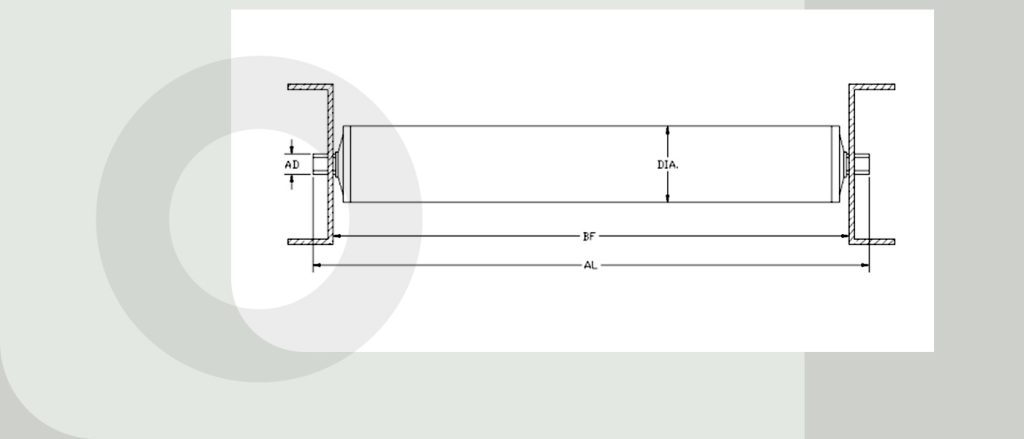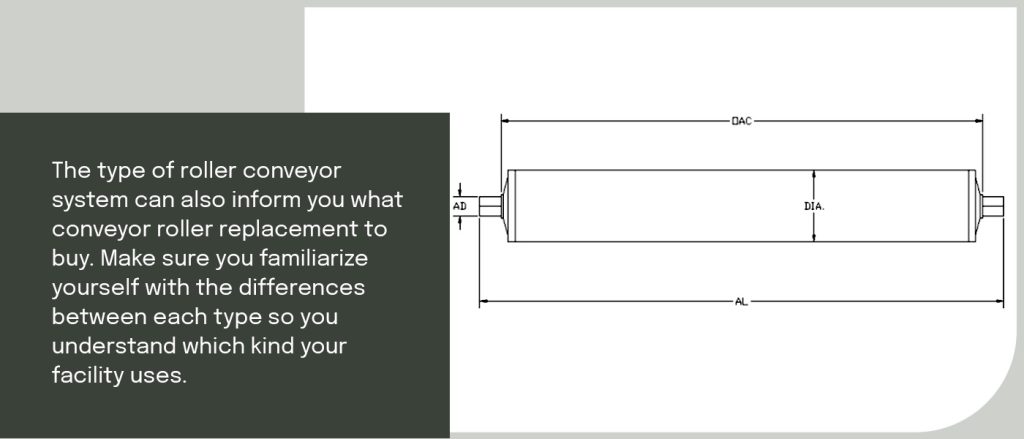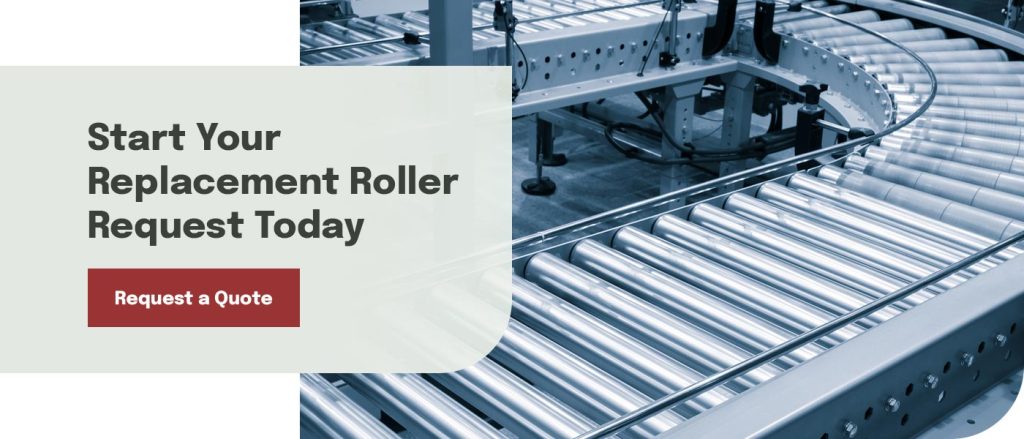
Ordering a new conveyor roller is easy and requires just a few critical dimensions to get the proper roller. Importance of measuring each part of the equipment. By taking down all this information, you will be fully prepared to find the replacement roller that fits your needs.
1. Measurement of Your Conveyor Roller
Finding the measurements of your conveyor roller is the first step in ordering a suitable replacement. It is best to take the dimensions while the roller is still in the conveyor because roller manufacturers may use different bearings but the conveyor frame will not change. To ensure you are ordering the correct replacement roller some of the measurements you should take include the following:
- Between frame distance (BF): Measure the distance from inside the frame on one side to inside of the frame on the other side.
- Total axle length (AL): Measure the distance from one end of the axle to the other.
- Roller diameter (DIA): Measure the outside of diameter of the roller.
- Axle diameter (AD): The diameter may vary depending on the shape of the axle. For example, if the axle is a hexagon, measure it from flat to flat. If the axle is circular, you can measure the diameter from the outside.
- Wall thickness: You can measure the wall thickness with calipers.
- Surface finish: The surface finish is typically galvanized or zinc-plated. Contact us now for other available options.
When measuring the “between frame” dimension of your conveyor roller it is best to take measurements from the frame. The frame acts as a static reference point for you to take accurate information.
In some cases, you may not be able to measure the roller when it is placed in the conveyor. If that is the case you can use the Overall Cone Dimension (OAC) measurement. This measurement is taken by measuring the outer most part of the bearing to the other outer most part of the bearing as seen here: Overall Cone Dimension Measurement
2. Configuration of Axle
The next step to buying a suitable roller replacement is finding your axle’s configuration. This involves finding the axle diameter, size, retention and length. Each measurement of the axle is crucial to finding the correct size. Otherwise, your new roller may not spin correctly or fit into the roller tube.
Axle Diameter
The axle diameter measures the distance between the edges of the axle. With hex axles, you will want to measure from flat edge to flat edge, but with a round axle, you’ll want to measure the diameter from the outside edges of the roller.
Axle Retention
Axle retention devices help to keep the axle in place when placed into the roller tube. The two most common types of retainers are spring retainers and pin retainers.
To test if your axle has a spring retainer, press one side of the axle. If it pushes in, it is spring retained on the opposite end. You can repeat this process on the other end to see if your axle is dual spring retained. As standard Rolcon uses axles are spring loaded on both ends. Some manufacturers will only spring load one end.
If your axle is pin retained, look to see if there are holes at the end of the axle. Holes indicate a place to insert retaining pins such as cotter pins.
Axle Length
Use a tape measure to find the measurement between the ends of the axles. You may also want to measure the length of the axle extension on either side of the bearing. Measure the extension by placing the tape measure from one end of the bearing to the other.

3. System Type
The type of roller conveyor system can also inform you what conveyor roller replacement to buy. Make sure you familiarize yourself with the differences between each type so you understand which kind your facility uses.
Gravity Roller
Gravity rollers are a basic conveyor system with a frame that contains free-rotating rollers. Using gravity to move the products along the conveyor, gravity rollers can work with lightweight or medium-weight items. These systems are a very cost-effective option.
Most are made of steel, plastic or aluminum and can come with various attachments like slide rails, supports, pop-up stops or curved sides. Gravity rollers work well as temporary rollers, skate wheel replacements, stacking loads or heavy-duty applications.
Belt-Driven Roller
Belt-driven rollers power each roller with a motorized belt to control the movement of products. A belt can help control the items by halting the control points, turning the products, unloading on the side and assisting in slide-loading applications.
You can tell a roller is belt-driven by looking at the shape and location of the frame. Often the V-shaped or straight rollers are higher than the frame to support extremely wide items. The belts are usually made with rubber and should not come into contact with debris, heat or moisture, as a clean and dry machine is needed to continue the halting and reverse of the belt-driven roller. Belt-driven rollers can transport medium and heavy products.
Chain-Driven Roller
Chain-driven roller conveyors use a chain to power each roller and move heavy items. They are often used when belt-driven rollers cannot be used due to extreme heat or a large amount of debris. Roll-to-roll chain rollers, for example, wrap around each roller and attach to sprockets on the conveyor. Chain-driven conveyors can also handle heavy-duty loads and are capable of reversing their direction.
Line Shaft Roller
A line shaft roller drives products down the conveyor using a rotating shaft and a belted roller. Many manufacturers enjoy how quiet and easy to maintain line shaft rollers are. Facilities can start and stop the machine without affecting other products on the line, making for a more efficient workplace. Line shaft roller conveyors can also be reversed, helping with accumulation problems, sorting issues and low back pressure.
Powered Roller
A powered roller uses power to push the items forward on the conveyor. They often use internal motors located in one out of every nine rollers. Powered rollers can handle small and light objects and include the ability to start and stop quickly.
Motor-Driven Live Roller
A new kind of roller, the motor-driven live roller (MDR), transports items using small DC motors built into the roller itself. These motors are spread throughout the conveyor and in zones where products tend to accumulate. The purpose of MDRs is to control the speed, direction and accumulation of items through the use of controller cards and photo eye inputs and sensors.
The advantages of MDRs include accumulation control for smaller items, easily replaceable bands and the ability to change the speed or incline of the objects using belts.
Start Your Replacement Roller Request Today
Since 1988, Rolcon has supplied conveyor products to distributors, handlers and other businesses across the country. Based in Ohio, our company is dedicated to providing the quality materials you need to help you streamline operations and boost productivity.
Many replacement rollers have different surface finishes. Get a quote from Rolcon to find one that’s right for you. Please fill out our contact form online to speak to a representative or call us today at 1-800-486-2472.
